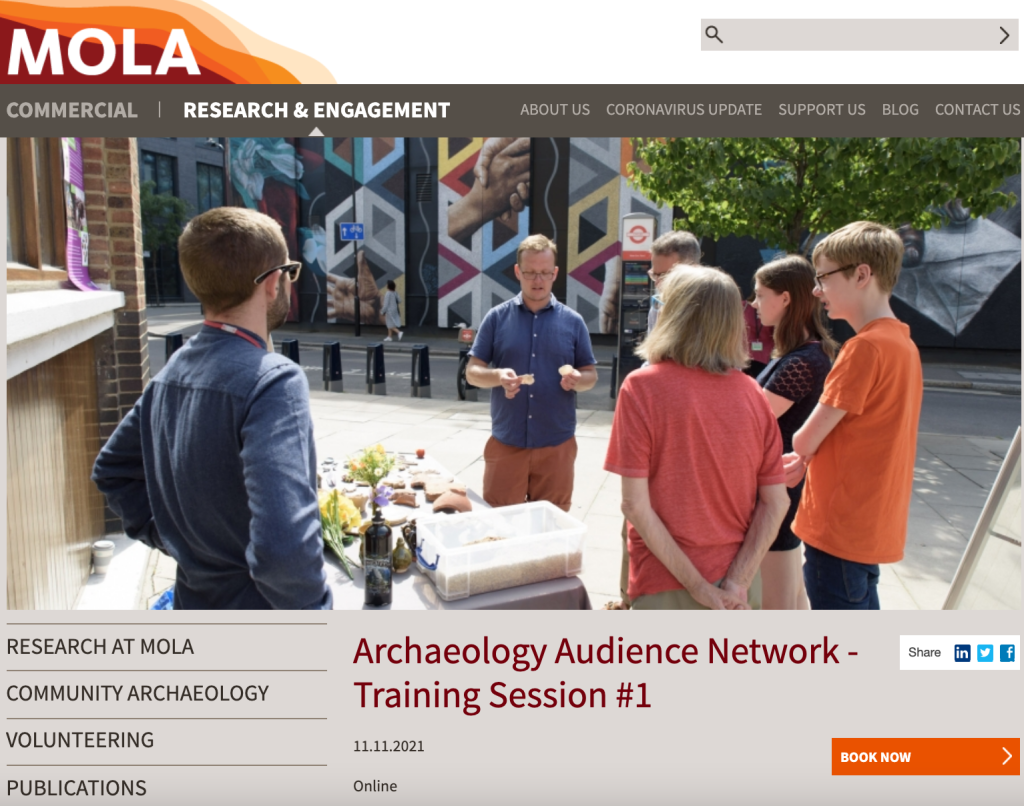
I hope you might join us Thursday, 11 November, 2021 at either 16:00-18:00 GMT or 18:00-20:00 GMT for the first Archaeology Audience Network (AAN) training session. This free event is for all of you interested in audiences and public engagement with archaeology, which I imagine would be everyone working in, studying, and otherwise keen on the discipline – as well as those involved in the wider heritage sector. More information on the session and some of the underpinning evidence for it is available on MOLA’s website. We are running it twice to accommodate demand
- Register for the 16:00 GMT event here
- Register for the 18:00 GMT iteration here
The AAN is a collaboration between archaeological organisations in England working to bring together, learn from, and improve our use of data about audiences in order to achieve more meaningful impacts. Collaborators include MOLA, the Archaeology Data Service, the Council for British Archaeology, DigVentures, Oxford Archaeology, Wessex Archaeology, and York Archaeological Trust, alongside a series of supporters from different professional and academic bodies. The Network will grow over time and we aim for it to be self-sustaining by the end of its formal two years of funding. This essential funding comes from the Department for Digital, Culture, Media & Sport (DCMS) and The National Lottery through The Heritage Fund’s Digital Skills for Heritage initiative.
It’s hard for me to express how much and for how long I’ve been keen to see this type of collaboration realised. My MOLA colleague Magnus Copps (Head of Programming and Partnerships) and I began to work on the proposal as soon as the funding opportunity was announced last year. We reached out to our close working partners and affiliates who we believed would be equally enthusiastic (they were!), and from there the Network was born. The funding from DCMS and The National Lottery has been pivotal to making it possible – it allows us to collate existing data, use lessons learned (both from the categories of data being collected and from the data themselves) to formulate and test out new approaches to engagement with different citizens, and create new models for good practice around audience data, building on the long-standing good practice work of the ADS.
Our first outward-facing event associated with the Network is next week’s introductory training session on Archaeology’s Audiences. We’ve had to re-jig the schedule for the event a couple of times already, both because this is a learning experience for us, and because this first session is important for us in ensuring we fully lay out the foundations for the Network, present its context, highlight its evolving nature (which is designed to be responsive to themes and trends as they emerge), and gauge interest and reactions from different individuals and groups.
Per above, we are running the same session twice on the same day (11 Nov, 16:00-18:00 GMT and 18:00-20:00 GMT), and recording the first (less interactive) part of the session for wider dissemination afterwards. The demand we’ve witnessed for this event perhaps further reinforces not just how much interest there is in the subject matter, but also how much need exists for amalgamation of existing/past work, and alignment of future thinking and practice on matters of audience data and audience evaluation in archaeology.
As we mentioned in our Digital Skills for Heritage application, public archaeology as it is practiced within the context of the UK planning process forms a significant avenue for audiences to access ‘live’ archaeological investigations and contribute hands-on insights into UK heritage. It has access to relatively substantial sources of funding outside of the usual research and charitable grant streams. It takes place around and under the living and working spaces of all demographics in the UK. And it tends to be grounded in activities that can generate short and long-term human outcomes but that lack the enduring physical presence that comes from capital investment in buildings, restoration, or static interpretation. In other words, it is a very special field of practice, with much insight about audience engagement to share—and with tremendous potential to shape archaeological and heritage research and practice in all its manifestations.
We hope you’ll follow along with the work of the Network (email: aan@mola.org.uk, hashtag: #archaeoAN) and join us for the first session on 11 November 2021.
